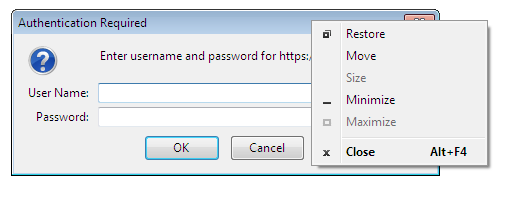In the field of automation testing, Selenium is an open-source versatile framework developed to test various web applications. It mainly ensures that the web applications are working properly as per the projected behavior.
What are Pop-ups?
Pop-up authentication is a basic type of data authentication process which protects web pages with user access credentials. When a user tries to access a protected zone of a website, the HTTP header requests this authentication by prompting the user to enter the credentials.
Types Of Pop-ups
The pop-up is a browsing concept that is a secondary part of a browser window that appears on the top of the main browser. The pop-up is an element data type of a particular Graphical User Interface (GUI) that appears on top of the current user window. They have been designed to catch the user’s attention with some specific pieces of notification. There are different types of pop-ups present on the web. Let’s discuss the –
Pop-ups with advertisements: These are the widespread pop-ups which mainly used to convey and display specific advertisements to users. The main problem with these types of pop-ups is, they are nosy. It causes the user to experience disruption.
Pop-ups with alerts: Alerts are short informational windows that mainly display the message to the users to collect the user’s assurance for a particular action. They have only two options “OK” or “Cancel”.
Pop-ups with confirmation: It is mostly similar to the alert pop-ups, which contain an “Apply” button along with the OK or Cancel buttons.
Prompt type pop-ups: They ask for the consent of the users to enter some specific pieces of information like text. They also contain the “OK” and “Cancel” switches.
Basic Authentication Pop-ups: It is one type of authentication dialog that appears when a user tries to access the protected area of a particular website. The user needs to enter the username along with the password or OTP to continue with the page.
Modal pop-ups: These types of pop-ups are a block interaction process for a window, which sustains until the closing of a page. In this, it is necessary to perform the consent process for a particular action before entering the page.
Non-modal type of pop-ups: These pop-ups are different and vice-versa from the modal type pop-ups. They appear on the top of the node content without blocking any interactions underlying the particular page.
Exit intended pop-ups: This pop-up appears when the user moves the cursor of the mouse to close the browser. They are the most annoying pop-ups designed to retain the users’ attention before leaving the page.
Subscription-aimed pop-ups: Subscription-aimed pop-ups create a strong follower base by subscribing to newsletters and updates by following the mailing lists. This type of pop-ups mainly asks for email addresses from the users, and in return, it gives some incentives to them.
Consent pop-up with cookies: With the General Data Protection Regulation and other privacy policies, there are so many websites using the cookie policies with consent. These typically ask the users to enter an email address with some attractive offers.
Total page overlay pop-ups: These pop-ups contain so many announcements, promotions, and lead generation setups to cover the entire webpage with important notifications.
The use of the above-mentioned pop-ups can be effective for spreading pieces of information and adding functionality to gain and retain more engaging users. Though, excessive pop-ups lead to poor user experiences, which may discourage the users from using it further.
How Does Selenium Actually Work?
The Selenium architecture is capable of developing a versatile tool for handling the authentication process with pop-ups. It enables the developers to create dynamic test scripts to improve the software quality by the following –
Selenium API Structure: It allows users to interact with web elements and platforms through a pop-up authenticator.
Browser Interaction Process: Selenium’s direct connection facility creates a communication channel between the user and websites through authentication.
Perform The Desired Actions: It is needed to satisfy the authentication process by pop-ups to perform the specific operation on the site.
Cloud-Based Testing Method: As we know, the cloud is a large pool of datasets and a sensitive sector too, so it is really important to deploy the authentication pop-ups.
Integration Testing Process and Frameworks: Selenium can deploy the pop-up authenticator by collaborating with TestNG and JUnit to increase the security of the data storage.
Selenium Facilities for The Authentication Process Handling
There are so many facilities you have when you attempt to handle the process of the pop-ups with authentication mechanisms. The process effectively enables all the Selenium features to authorize individual users to gain access to sensitive resources. Here are the possible steps mentioned below –
Provide the data to the URL: It is the most common approach to hide the basic authentication values with pop-ups to input the user id and password in the URL directly. Selenium allows users to develop URLs for the further navigation process.
Encapsulate the login formations: For the web application, Selenium can interact with the database as a form. Here users will submit the credentials as a login formation with a program.
Handling the alert process: For the JavaScript codes, the pop-up structures work as an alert process with the help of Selenium. This is a browser-based process in general.
Cookies hiding process: For some processes, websites use cookies to satisfy the authentication process. Selenium allows the user to manage cookies which are useful for maintaining the authentication for test processes.
Consider all browsers: For the pop-up processes, it is needed to keep some backups in the browser section. When you are using headless browsers, it is necessary to set so many authentication channels to handle proxy processes.
How Selenium Functions with Authenticator
The authenticators are widely used security maintenance services, which significantly secure the process by adding an extra layer of protection to complete the authentication to get entry into the process. As cyber threats are evolving so much these days, developers prefer to incorporate multi-layer and multi-factor authentication processes to save classified pieces of information. As a part of the border concept, there are two types of authentication processes denoted as multi-factor authentication (MFA) and two-factor authentication (2FA). Based on them, you have three types of authenticators in use –
Hardware Authenticator System: It is a physical device authenticator system, totally run by OTP. The user tries to authenticate by logging in with some hardware prompt along with the regular password.
Software Authenticator System: It can be installed on the user devices, such as smartphones or computers. These apps generate the one-time passcode through a push notification to get login approval. Examples: Google and Microsoft have their authenticator.
Biometric Authentication System: It is a unique authenticator which runs only through biometric processes like fingerprints, face features, and iris patterns.
Selenium has no features to make a direct connection with biometric hardware devices. For this, users need to install biometric APIs to operate the process at the system level.
Handling Authentication Pop-ups and Processes in Selenium Environment
The pop-up is a browsing concept that is a secondary part of a browser window that appears on the top of the main browser. Pop-up authentication is a basic type of data authentication process which protects web pages with user access credentials. When a user tries to access a protected zone of a website, the HTTP header requests this authentication by prompting the user to enter the credentials. Authentication pop-up handling in a Selenium environment is possible but it is a tricky process. This process mainly occurs when a website requires to collect the user inputs to access the page functionalities instead. Here are the step-by-step processes for how you can handle authentication pop-ups on a Selenium automation testing environment.
Primary Popups for Authentication: Some websites use primary authentication pop-up features that lead to collecting the input from the user in a predefined URL. But developers should remember that deploying credentials in an URL directly is not a secure process for sensitive datasets.
HTTP Basic Authentication Handling Pop-ups: If you encounter the basic authentication pop-ups which are mainly triggered by the respective browser of the website itself, then you can use Selenium to handle it.
Custom Authentication Process Handling: If a website runs through the custom login process with the regular HTML elements, the developers can locate the specific elements by interacting with them with another data file of the entire process.
Cookies Handling for The Manual Sites: If the website runs by the manual login process with the related authentication cookies, the developers can deploy Selenium to bypass the login entirely.
Handling an authentication with pop-ups always relates to sensitive programs and has so many legal procedures. Keeping in mind the website behavior and authentication approaches may change time-to-time.
LambdaTest offerings under Pop-up Authentication Handled in Selenium
LambdaTest is a digital experience testing platform that offers businesses to reduce time to marketing without compromising website performance and quality. By facilitating both real-time and automated testing across 3000+ environments and actual mobile devices, LambdaTest ensures high-quality releases and expedites digital transformation efforts. Here are steps to follow to handle authentication pop-ups in Selenium.
Sign up and log in: Go to the LambdaTest site and sign up for the new account. If you have an account on LambdaTest, then log in.
Set the drivers for Selenium: Install the proper Selenium drivers in your preferred coding language.
Configure the capabilities: Design the capabilities of the project on the LambdaTest cloud service. Set up the LambdaTest grids to execute the remote test.
Handle the capabilities for pop-ups: Develop authentication credentials with the URL. Access the page then by initializing Web Drivers.
Perform the actions for the Protected pages: Use the Selenium commands to access the protected pages.
Complete The Whole Test: Execute the tests further with actions on the protected page.
Conclusion
With a combination of Selenium, LambdaTest offers a flexible and wide range of pop-up handling processes to authenticate the user request. It enables the developers and testers to cover the test process in an improved module by raising the entire quality of the project, as any automated testing offers the essentials to ensure the mechanisms which compile the system code with high security by following the authorization policies simultaneously. Moreover, the LambdaTest platform supports cookie policies to simplify the process of bypassing the login mechanisms by saving them from the past login history.





![Manual Testing vs Automated Testing: Key Differences [2023]](https://thenewsgod.com/wp-content/uploads/2023/08/Manual-Testing-vs-Automated-Testing-150x150.png)








